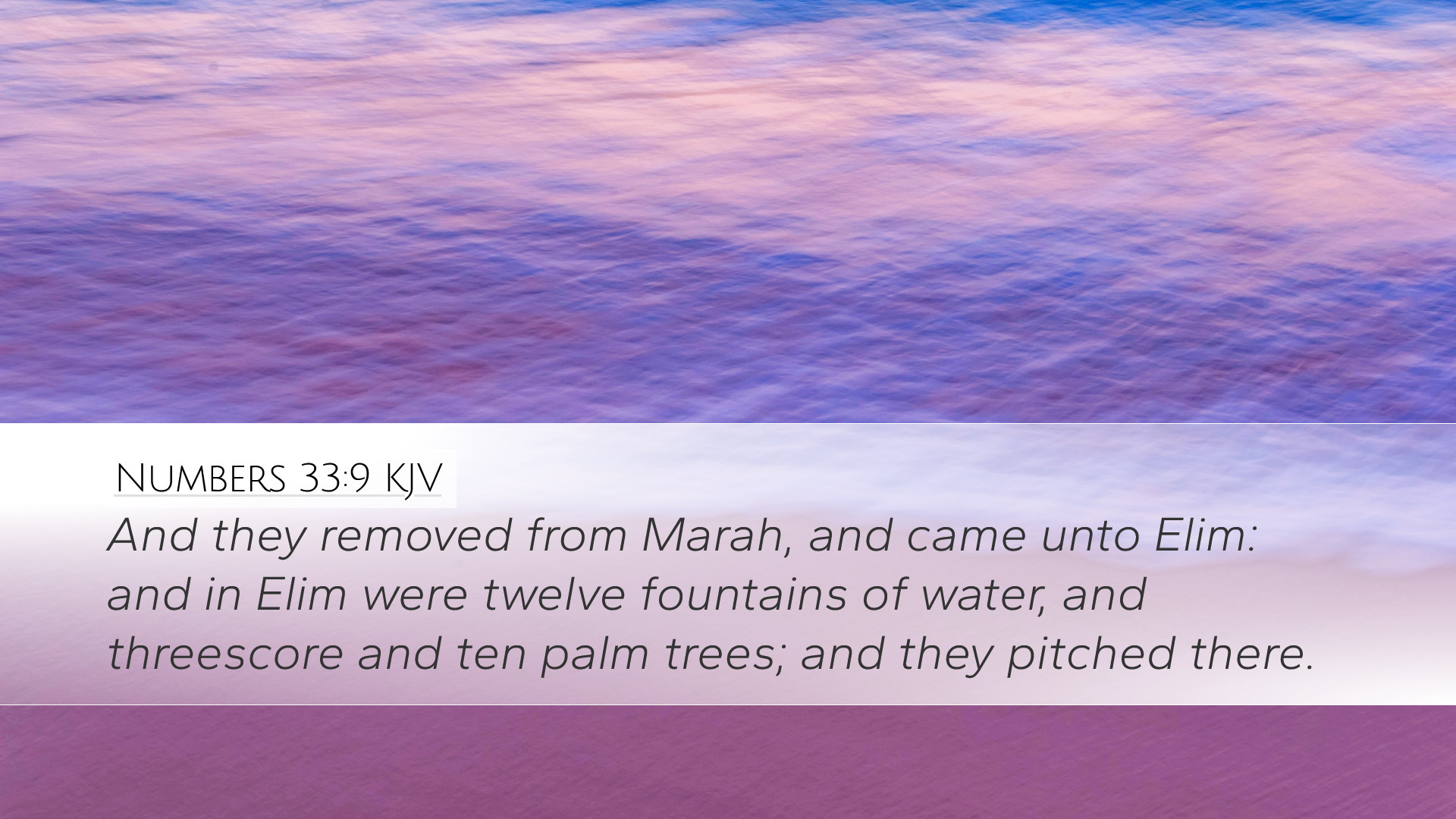Commentary on Numbers 33:9
Verse Text: "And they removed from Marah, and came unto Elim: and in Elim were twelve fountains of water, and threescore and ten palm trees; and they pitched there."
Introduction
This verse presents a transition in the wilderness journey of the Israelites, marking their passage from a place of bitterness to a location characterized by abundance and restoration. It encapsulates the themes of divine provision and the importance of spiritual renewal.
Context of Numbers 33
The thirty-third chapter of Numbers records the stages of Israel's journey from Egypt to the Promised Land. This chapter serves as a chronological map and highlights significant locations that symbolize pivotal experiences in the community of Israel. Notably, the verse follows the Israelites' bitter experience at Marah, where they encountered unpalatable water.
From Bitterness to Blessing
- Significance of Marah: Marah symbolizes the trials and bitterness of life. The Israelites' experience there illustrates the realities of human suffering and the challenges in their journey towards God's promises.
- The Role of Faith: The removal from Marah signifies an act of obedience and trust in God. The Israelites responded to God's guidance, a theme emphasized by Matthew Henry, who notes that despite their complaints, God still led them forward.
- Transition to Elim: Elim represents God’s provision after trial. The shift to Elim signifies a move from despair to restoration, where God reveals His ability to provide abundantly, often where we least expect it.
Details of Elim
Elim is a place of refreshment, featuring twelve fountains of water and seventy palm trees. This imagery is significant, suggesting totality—a fountain for each tribe and palm trees signifying rest and vitality.
Symbolism of Water and Trees
- Twelve Fountains of Water: The twelve fountains symbolize the sustenance that God provides to His people. Water is a biblical symbol of life and renewal, often associated with the Holy Spirit's work in the life of believers (see John 7:38-39).
- Seventy Palm Trees: The palm tree is emblematic of victory and peace. Its presence at Elim signifies the importance of divine peace in the life of those who follow God. Palm trees also suggest a place of rest and safety amid the wilderness.
Theological Insights
This verse invites deeper theological reflection on God's character as a provider and sustainer. The journey from Marah to Elim appears as a metaphor for the Christian life, characterized by trials leading to spiritual renewal.
Insights from Commentaries
- Matthew Henry: Henry emphasizes the goodness of God in leading His people from trials to comfort, illustrating God’s faithfulness in times of distress. He notes that God often brings His people into 'Elim' after their faith has been tested.
- Albert Barnes: Barnes comments on the geographical and spiritual significance of Elim. He asserts that it is a manifestation of God’s grace, marking the importance of recognizing God’s blessings amid hardships.
- Adam Clarke: Clarke reflects on the representational meaning of the fountains and trees, explaining how they symbolize the blessings of the Christian life. He draws parallels with the New Testament, where Jesus offers living water, a theme that resonates throughout Scripture.
Practical Applications
The transition from Marah to Elim offers profound implications for personal and communal faith journeys.
For Pastors and Leaders
- Encouragement in Trials: Leaders can encourage their congregations to recognize that trials are part of the journey but are often precursors to God's blessings. Like the Israelites, they are called to trust God amid uncertainty.
- Fostering Community: Just as Elim provided physical and spiritual nourishment, church leaders can create environments where spiritual refreshment is prioritized, echoing the themes of community support and shared blessings.
For Students and Theologians
- Exploring Themes of Provision: The verse invites theological exploration of God's provisions in Scripture. The fountains and trees are an opportunity to examine how God’s blessings manifest in various contexts throughout the biblical narrative.
- Reflective Study: Engaging with the transition from bitterness to blessing prompts students to reflect on their journeys. They are encouraged to identify their 'Marahs' and 'Elims' as they study God's transformative power.
Conclusion
Numbers 33:9 serves as a powerful reminder of God's leading hand in the lives of His people. The journey from Marah to Elim encapsulates the movement from despair to hope, resonating deeply with the Christian experience. By reflecting on the richness of God's provision, believers are encouraged to embrace faith and anticipate divine renewal, even amid life's most challenging circumstances.


